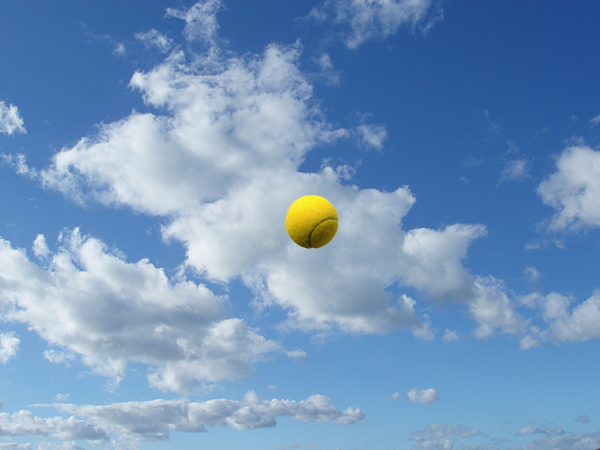Tossing A Ball

I throw a ball up in the air with some initial velocity v 1 and it stays in the air for some time t 1 . I then throw the ball straight up with velocity v 2 and find that this time it stays in the air for a time t 2 = 2 t 1 . What is v 2 / v 1 ?
The answer is 2.
This section requires Javascript.
You are seeing this because something didn't load right. We suggest you, (a) try
refreshing the page, (b) enabling javascript if it is disabled on your browser and,
finally, (c)
loading the
non-javascript version of this page
. We're sorry about the hassle.
19 solutions
We have
x
=
−
2
g
t
2
+
v
0
t
(Assuming the ball is thrown from
x
=
0
) .
When the balls gets back to the ground:
x
=
0
(with
t
=
0
) then,
v
1
=
−
2
g
t
1
and
v
2
=
−
2
g
t
2
=
−
g
t
1
.
v
1
v
2
=
−
2
g
t
1
−
g
t
1
=
2
.
v = u + a t
Given that acceleration due to gravity is the same for the two throws, we know that v ∝ t . This means that if you double t , you also double v .
Since t 2 = 2 × t 1 ,
v 2 = 2 × v 1
∴ v 1 v 2 = 2
V=u-gt where u=0unit and g is constant !!
a formula for this case is:
t = s/v
t = time s = distance v = velocity
from above formula, we can take a conclude that if t is become twice bigger than before, then v is become a half of before.
for 1st ball 0=V1-gt1 V1=gt1
for 2nd ball 0=V2-gt2 V2=gt2
V2/V1=t2/t1=2
s=ut+at^{2}/2 s=o we get v=gt/2 hence v2 /v1=t2/t1 =2
If time taken for second ball is half as time taken for first ball then the speed of second ball should be twice as first ball ,
So speed of first ball be anything but it is half as second ball ,
So let the speed of first ball be 1(v1) then the speed for second ball equals to 2 (v2) ,
2(v2) / 1 (v1) = 2..
final velocity(v)=0 unit, v=v(1)-g t(1)...................(1) v=v(2)-g t(2)...................(2) 2/1 then,answer will be 2
when the ball moves up with velocity vi and when it is thrown 2nd time it moves up with velocity v2.the first ball takes time t and 2nd ball takes time t2 which is double so it means its velocity is also double .when we take any number instead of velocity its answer is always 2 like this v2/v1 when we take v2=10 and v1=5 because v2 is double that of v1 then 10/5 becomes equal to 2
yours one is the best answer
for 1st ball 0=v1-gt1 v1=gt1
for 2nd ball 0=v2-gt2 v2=gt2
v2/v1=t2/t1=2
velocity 1st case is (at) in 2nd case is (2at) dividing 2nd by 1st =2.
as t2=2t1 => v2/v1=2t1/t1 => v2/v1=2
u can solve it through......v=u-gt
v2/v1 = t2/t1 ---> v2/v1 = 2t1/t1 = 2 [m/s]. Answer : 2
as we know that this comes under time of ascent so V=-GT V1=-9.81 T(T=T1) V2=-9.81 2T(T2=2T1) V2/V1=-9.81 T/-9.81 2T V2/V1=2
Well,the time and speed are directly proportionals,so if the T2 = 2xT1,we have the conclusion that V2 = 2xV1, so , 2/1 = 2.
for both cases final velocity ie V(f) will be equal to zero for the case 1 V(f)=v1 -gt 0=v1-gt for the case 2 v(f)=v2-g t1 0=v2-2g t1 v1/v2=2
v=u+at. In this case u is 0, thus, v=at thus v is directly proportinal to time. so,T2=2T1. So v2=2V1 v2/v1=2
how u is 0 in this case ?
plz see the question...it stays in d air..so that the final velocity u=0
The formula for vertical motion up is v t = v 0 − g t
Since the v t is 0 , so the formula becomes v 0 = g t
v 1 = g t 1
Then..
v 2 = g t 2
v 2 = 2 g t 1
So..
v 1 v 2 = g t 1 2 g t 1
v 1 v 2 = 1 2 = 2